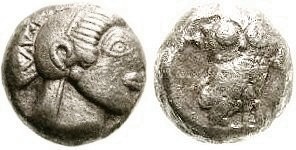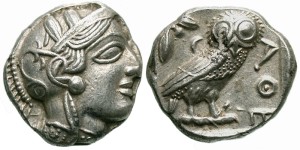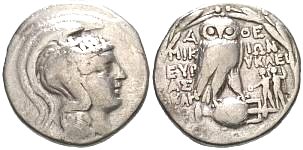The early artistic development of coins is divided into three categories.
Archaic Greek Coins
The first is the Archaic coin category (510-480 B.C). In the "Archaic period" coins were fairly crude by later
standards. They were mostly small disk-shaped lumps of gold, silver, or bronze, stamped with a geometric design or
symbol to indicate its city of origin. As coining techniques improved, coins became more standardized as flat circular
objects and the convention of putting a representation of the patron deity of the issuing city became established. Animal
symbols such as the bees (sacred to Artemis) of Ephesus, turtles of Aegina, or the owl (sacred to Athena) of Athens were
also widely used. The images on these coins were mainly of sacred animals, such as lions and bulls that
held important religious significance. Before too long, the obverse of these coins depicted "busts" (head and shoulders)
and the reverse depicted a full-figured animal or deity. These were prominent in the years before 479 BC, and are
characterized by their thickness in form and heavy weight. They also had very little writing - often with only an
abbreviated form of the issuing city inscribed.

Artistically, archaic coin images lack perspective; for example, the profile of a certain God may be
depicted on the "head" of the coin, yet the eye will still be placed in the centre of the face, as if that humanlike head
had eyes on the side of its face. Profiles like these are commonly found among Egyptian figures, with their stiff posture
and highly stylized features. Archaic coin images place much emphasis on sacred symbolism and closeness with Nature.
Classical Greek Coins
The era of Classical Greek art in titles of coins appeared around the year 479 BC and lasted through to the ascension
of Alexander the Great. Larger cities produced a range of fine silver and gold coins, most bearing a portrait of their
patron god or goddess, or a legendary hero, on one side, and a symbol of the city on the other. Some coins employed a visual
pun: coins from Rhodes featured a rose, since the Greek word for rose is rhodon. The use of inscriptions on coins also
began, usually the name of the issuing city, although like archaic coins, classical Greek coins show very little writing.
The wealthy cities of Sicily produced some especially fine coins. The large silver decadrachm (ten drachm) coin from
Syracuse is regarded by many collectors as the finest coin produced in the ancient world, perhaps ever.
The use of coins for propaganda purposes was a Greek invention. Coins are valuable, durable and pass
through many hands. In an age without newspapers or other mass media, they were an ideal way of disseminating a political
message. The first such coin was a commemorative decadrachm issued by Athens following the Greek victory in the Persian Wars.
On these coins the owl of Athens was depicted facing the viewer with wings outstretched, holding a spray of olive leaves.
The message was that Athens was powerful and victorious, but peace-loving.

Around 525 BC there came into circulation the popular Athena/Owl tetradrachm, which bore the head of the Athena,
patron goddess of Athens on the obverse, with an image of her animal, an owl, on the reverse. Between 449 and 413 BC
huge quantities of tetradrachms were minted to finance grandiose building projects such as the Parthenon and to cover
the costs of the Peloponnesian War. The obverse depicts the head of Athena right with almond shaped eye, wearing crested
helmet ornamented with three olive leaves over the visor and a spiral floral scroll on the bowl, her hair is drawn across
the forehead in parallel curves. The reverse depicts an owl standing right, head facing, erect in posture, prong tail,,
to the left is an olive twig and crescent, all within incuse square.
Hellenistic Coins
Although some cities managed to remain independent in the Hellenistic period, the Hellenistic world was above all
characterized by kingdoms. First the immense empire of Alexander the Great, and after his death the smaller kingdoms carved
out of it by his closest associates, the Diadochs or Successors. Out of the political concerns of these kings came the
single most important development in Hellenistic coinage, the appearance of the ruler portrait on the obverse of many of
their coins, providing us with our first relatively realistic look at the historical figures of the ancient world.
The portraits are masterpieces of Hellenistic art, depicting in fine detail not only the features of
the men (and occasionally women) about whom we often know so little, but also indications of how their subjects were
intended to regard them.
The Hellenistic practice of using portraits on coins had in fact appeared earlier in the East, in Lycia and in Persia,
where as early as the late fifth century BC coins of some local dynasts and provincial governors bore relatively
realistic-looking heads identified by inscription. However, this practice was in sharp contrast to Greek custom, which
primarily used deities, heroes, and their attributes as coin types. In fact, it was disapproved of by other Greeks as
showing hubris (pride). But the kings of Ptolemaic Egypt and Seleucid Syria had no such scruples, and issued magnificent
gold coins adorned with their own portraits, with the symbols of their state on the reverse. The names of the kings were
frequently inscribed on the coin as well. This established a pattern for coins which has persisted ever since: a portrait
of the king, usually in profile and striking a heroic pose, on the obverse, with his name beside him, and a coat of arms
or other symbol of state on the reverse.

Alexander III (356-323 BC), who became king of Macedon in 336 BC and who by the time of his death in 323 BC had conquered
much of the world known to the West, followed the example of his father Philip and depicted Greek deities and heroes on his
coins. His coins depicting the hero Herakles, from whom the Macedonian royal family claimed descent, are particularly
significant in the development of the Hellenistic coin portrait. The head of Herakles appeared on Alexander's bronze and
silver coins, the most important of which were his tetradrachms, which soon eclipsed Athenian tetradrachms as the most
widely circulated and authoritative coins in the ancient world.
Although there is no evidence to suggest that Alexander regarded these images as portraits of himself, it appears likely
that in parts of his empire where he had acquired the status of a hero or even a god and where his achievements were equated
with those of his patron hero, the image was widely regarded as an image of the king himself. And after Alexander's death,
the Successors continued to issue the coins without changes of type, undoubtedly because the prestige of the coins was so
great and because the use of Alexander's types strengthened their claims to be the legitimate heirs of his kingdom.
After Alexander died, his Empire was split up among his many generals. Coins of the Hellenistic era usually had depictions
of the existing ruler of the city-state on the obverse, while the reverse had pictures of civic symbols or city badges.
Included on both sides of these coins were multi-word legends along with the names of the minting cities. It would take
another couple of decades for the portrait of a living king to appear on the obverse of coins. This occurred in 306 when
Ptolemy (one of the many successors of Alexander) issued a series of coins that saw him likened to the image of Zeus with
his thunderbolt. Portraiture would continue through in abundance on coins in both the Republic and Imperial eras of Ancient
Rome, though Roman coin illustrations on the whole remained much more stiff, harsh, and stylized than Greek coin images.
The pattern of coin design that developed thousands of years ago can still be seen in our coins today.
On the American penny, a profile of Abraham Lincoln graces the obverse, with an image of the Lincoln Memorial on the reverse.
On every Canadian coin, the portrait of Queen Elizabeth can be seen, paired either with a civic symbol or animal on the back.
The perseverance of this style of coin design attests to its incredible power in symbolizing and broadcasting the history,
power and ideals of a culture or nation.